Bio-inspired computational memory model of the Hippocampus: an approach to a neuromorphic spike-based Content-Addressable Memory

Bio-inspired computational memory model of the Hippocampus: an approach to a neuromorphic spike-based Content-Addressable Memory
Daniel Casanueva-Morato, Alvaro Ayuso-Martinez, Juan P. Dominguez-Morales, Angel Jimenez-Fernandez, Gabriel Jimenez-Moreno
AbstractThe brain has computational capabilities that surpass those of modern systems, being able to solve complex problems efficiently in a simple way. Neuromorphic engineering aims to mimic biology in order to develop new systems capable of incorporating such capabilities. Bio-inspired learning systems continue to be a challenge that must be solved, and much work needs to be done in this regard. Among all brain regions, the hippocampus stands out as an autoassociative short-term memory with the capacity to learn and recall memories from any fragment of them. These characteristics make the hippocampus an ideal candidate for developing bio-inspired learning systems that, in addition, resemble content-addressable memories. Therefore, in this work we propose a bio-inspired spiking content-addressable memory model based on the CA3 region of the hippocampus with the ability to learn, forget and recall memories, both orthogonal and non-orthogonal, from any fragment of them. The model was implemented on the SpiNNaker hardware platform using Spiking Neural Networks. A set of experiments based on functional, stress and applicability tests were performed to demonstrate its correct functioning. This work presents the first hardware implementation of a fully-functional bio-inspired spiking hippocampal content-addressable memory model, paving the way for the development of future more complex neuromorphic systems.


